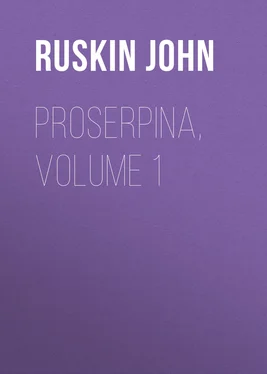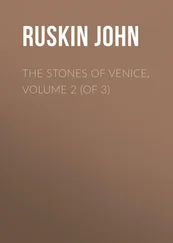John Ruskin - Proserpina, Volume 1
Здесь есть возможность читать онлайн «John Ruskin - Proserpina, Volume 1» — ознакомительный отрывок электронной книги совершенно бесплатно, а после прочтения отрывка купить полную версию. В некоторых случаях можно слушать аудио, скачать через торрент в формате fb2 и присутствует краткое содержание. Жанр: foreign_antique, Биология, literature_19, foreign_edu, на английском языке. Описание произведения, (предисловие) а так же отзывы посетителей доступны на портале библиотеки ЛибКат.
- Название:Proserpina, Volume 1
- Автор:
- Жанр:
- Год:неизвестен
- ISBN:нет данных
- Рейтинг книги:3 / 5. Голосов: 1
-
Избранное:Добавить в избранное
- Отзывы:
-
Ваша оценка:
- 60
- 1
- 2
- 3
- 4
- 5
Proserpina, Volume 1: краткое содержание, описание и аннотация
Предлагаем к чтению аннотацию, описание, краткое содержание или предисловие (зависит от того, что написал сам автор книги «Proserpina, Volume 1»). Если вы не нашли необходимую информацию о книге — напишите в комментариях, мы постараемся отыскать её.
Proserpina, Volume 1 — читать онлайн ознакомительный отрывок
Ниже представлен текст книги, разбитый по страницам. Система сохранения места последней прочитанной страницы, позволяет с удобством читать онлайн бесплатно книгу «Proserpina, Volume 1», без необходимости каждый раз заново искать на чём Вы остановились. Поставьте закладку, и сможете в любой момент перейти на страницу, на которой закончили чтение.
Интервал:
Закладка:
18. Hence generally, I think we may conclude thus much,—that at every pore of its surface, under ground and above, the plant in the spring absorbs moisture, which instantly disperses itself through its whole system "by means of some permeable quality of the membranes of the cellular tissue invisible to our eyes even by the most powerful glasses" (p. 326); that in this way subjected to the vital power of the tree, it becomes sap, properly so called, which passes downwards through this cellular tissue, slowly and secretly; and then upwards, through the great vessels of the tree, violently, stretching out the supple twigs of it as yon see a flaccid waterpipe swell and move when the cock is turned to fill it. And the tree becomes literally a fountain, of which the springing streamlets are clothed with new-woven garments of green tissue, and of which the silver spray stays in the sky,—a spray, now, of leaves.
19. That is the gist of the matter; and a very wonderful gist it is, to my mind. The secret and subtle descent—the violent and exulting resilience of the tree's blood,—what guides it?—what compels? The creature has no heart to beat like ours; one cannot take refuge from the mystery in a 'muscular contraction.' Fountain without supply—playing by its own force, for ever rising and falling all through the days of Spring, spending itself at last in gathered clouds of leaves, and iris of blossom.
Very wonderful; and it seems, for the present, that we know nothing whatever about its causes;—nay, the strangeness of the reversed arterial and vein motion, without a heart, does not seem to strike anybody. Perhaps, however, it may interest you, as I observe it does the botanists, to know that the cellular tissue through which the motion is effected is called Parenchym, and the woody tissue, Bothrenchym; and that Parenchym is divided, by a system of nomenclature which "has some advantages over that more commonly in use," 19 19 Lindley, 'Introduction to Botany,' vol. i., p. 21. The terms "wholly obsolete," says an authoritative botanic friend. Thank Heaven!
into merenchyma, conenchyma, ovenchyma, atractenchyma, cylindrenchyma, colpenchyma, cladenchyma, and prismenchyma.
20. Take your laurel branch into your hand again. There are, as you must well know, innumerable shapes and orders of leaves;—there are some like claws; some like fingers, and some like feet; there are endlessly cleft ones, and endlessly clustered ones, and inscrutable divisions within divisions of the fretted verdure; and wrinkles, and ripples, and stitchings, and hemmings, and pinchings, and gatherings, and crumplings, and clippings, and what not. But there is nothing so constantly noble as the pure leaf of the laurel, bay, orange, and olive; numerable, sequent, perfect in setting, divinely simple and serene. I shall call these noble leaves 'Apolline' leaves. They characterize many orders of plants, great and small,—from the magnolia to the myrtle, and exquisite 'myrtille' of the hills, (bilberry); but wherever you find them, strong, lustrous, dark green, simply formed, richly scented or stored,—you have nearly always kindly and lovely vegetation, in healthy ground and air.
21. The gradual diminution in rank beneath the Apolline leaf, takes place in others by the loss of one or more of the qualities above named. The Apolline leaf, I said, is strong, lustrous, full in its green, rich in substance, simple in form. The inferior leaves are those which have lost strength, and become thin, like paper; which have lost lustre, and become dead by roughness of surface, like the nettle,—(an Apolline leaf may become dead by bloom , like the olive, yet not lose beauty); which have lost colour and become feeble in green, as in the poplar, or crudely bright, like rice; which have lost substance and softness, and have nothing to give in scent or nourishment; or become flinty or spiny; finally, which have lost simplicity, and become cloven or jagged. Many of these losses are partly atoned for by gain of some peculiar loveliness. Grass and moss, and parsley and fern, have each their own delightfulness; yet they are all of inferior power and honour, compared to the Apolline leaves.
Fig. 3.
22. You see, however, that though your laurel leaf has a central stem, and traces of ribs branching from it, in a vertebrated manner, they are so faint that we cannot take it for a type of vertebrate structure. But the two figures of elm and alisma leaf, given in Modern Painters (vol. iii.), and now here repeated, Fig. 3, will clearly enough show the opposition between this vertebrate form, branching again usually at the edges, a , and the softly opening lines diffused at the stem, and gathered at the point of the leaf b , which, as you almost without doubt know already are characteristic of a vast group of plants, including especially all the lilies, grasses, and palms, which for the most part are the signs of local or temporary moisture in hot countries;—local, as of fountains and streams; temporary, as of rain or inundation.
But temporary, still more definitely in the day, than in the year. When you go out, delighted, into the dew of the morning, have you ever considered why it is so rich upon the grass;—why it is not upon the trees? It is partly on the trees, but yet your memory of it will be always chiefly of its gleam upon the lawn. On many trees you will find there is none at all. I cannot follow out here the many inquiries connected with this subject, but, broadly, remember the branched trees are fed chiefly by rain,—the unbranched ones by dew, visible or invisible; that is to say, at all events by moisture which they can gather for themselves out of the air; or else by streams and springs. Hence the division of the verse of the song of Moses: "My doctrine shall drop as the rain; my speech shall distil as the dew: as the small rain upon the tender herb , and as the showers upon the grass."
23. Next, examining the direction of the veins in the leaf of the alisma, b , Fig. 3, you see they all open widely, as soon as they can, towards the thick part of the leaf; and then taper, apparently with reluctance, pushing each other outwards, to the point. If the leaf were a lake of the same shape, and its stem the entering river, the lines of the currents passing through it would, I believe, be nearly the same as that of the veins in the aquatic leaf. I have not examined the fluid law accurately, and I do not suppose there is more real correspondence than may be caused by the leaf's expanding in every permitted direction, as the water would, with all the speed it can; but the resemblance is so close as to enable you to fasten the relation of the unbranched leaves to streams more distinctly in your mind,—just as the toss of the palm leaves from their stem may, I think, in their likeness to the springing of a fountain, remind you of their relation to the desert, and their necessity, therein, to life of man and beast.
24. And thus, associating these grass and lily leaves always with fountains, or with dew, I think we may get a pretty general name for them also. You know that Cora, our Madonna of the flowers, was lost in Sicilian Fields: you know, also, that the fairest of Greek fountains, lost in Greece, was thought to rise in a Sicilian islet; and that the real springing of the noble fountain in that rock was one of the causes which determined the position of the greatest Greek city of Sicily. So I think, as we call the fairest branched leaves 'Apolline,' we will call the fairest flowing ones 'Arethusan.' But remember that the Apolline leaf represents only the central type of land leaves, and is, within certain limits, of a fixed form; while the beautiful Arethusan leaves, alike in flowing of their lines, change their forms indefinitely,—some shaped like round pools, and some like winding currents, and many like arrows, and many like hearts, and otherwise varied and variable, as leaves ought to be,—that rise out of the waters, and float amidst the pausing of their foam.
Читать дальшеИнтервал:
Закладка:
Похожие книги на «Proserpina, Volume 1»
Представляем Вашему вниманию похожие книги на «Proserpina, Volume 1» списком для выбора. Мы отобрали схожую по названию и смыслу литературу в надежде предоставить читателям больше вариантов отыскать новые, интересные, ещё непрочитанные произведения.
Обсуждение, отзывы о книге «Proserpina, Volume 1» и просто собственные мнения читателей. Оставьте ваши комментарии, напишите, что Вы думаете о произведении, его смысле или главных героях. Укажите что конкретно понравилось, а что нет, и почему Вы так считаете.












